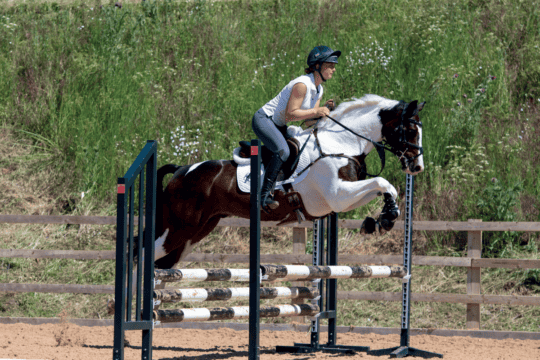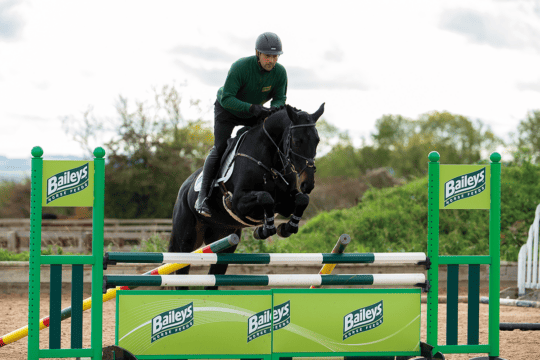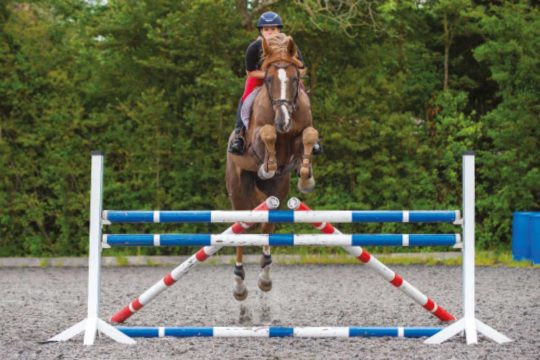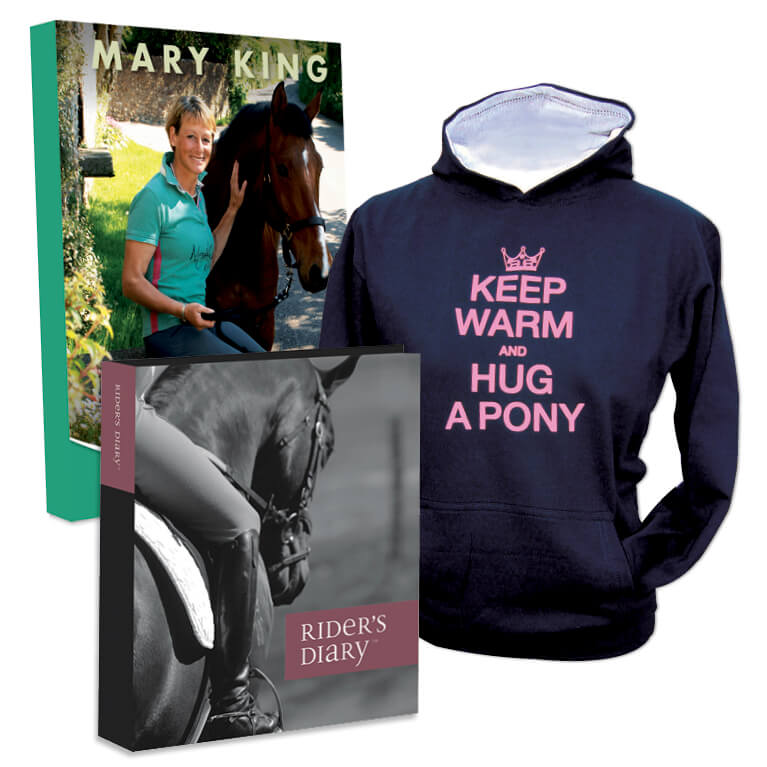-
Riding Schooling and Training
-
Health and Veterinary
-
Management
-
Mind Matters
-
Buying and Selling
-
Insurance Advice
FAQs
Cross-country schooling made simple with Harry Meade
Posted in Riding Schooling and Training Jumping
Unfocused across country? Eventer Harry Meade explains how to get on the straight and narrow
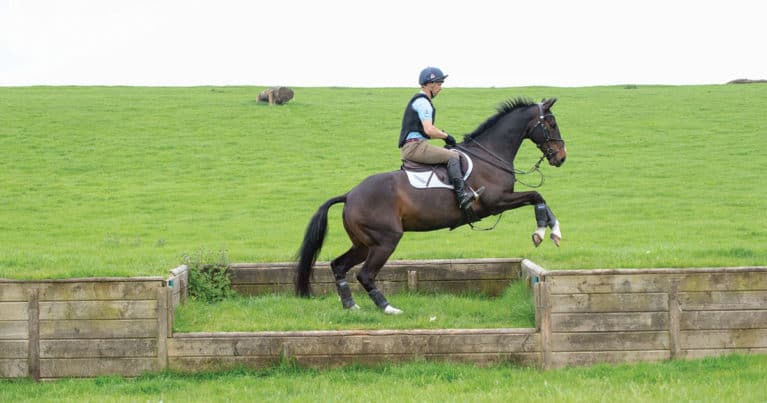
Horses learn the most when they’re going steadily and are given time to think about the task at hand. This is true whatever discipline you’re doing, but especially across country. However, go to any cross-country schooling facility and you’re likely to see people zooming around way too fast. As a rider, your priority should be giving your horse the most sympathetic and supportive approach possible to a fence. This means ensuring straight approaches and minimal interference.
Forward focus
Some horses lack focus across country and are prone to spooking between fences. This happens when your horse isn’t truly in front of your leg. This is a significant problem because you can’t control the direction if he’s not in front of your leg. It’s like driving at 25mph in fifth gear – you’ll always be labouring. His engine has to work for you, so drop down to third gear and suddenly you’ll have much more power.
It’s also important to remember that impulsion comes before straightness – you cannot have straightness without impulsion. If you turn off a boat engine, it doesn’t matter how you steer – it will just drift around with the current. As soon as you put in some forward momentum, you can steer. It’s the same with your horse.
Straighten up
Pick a point in the distance, but don’t ride straight from where you are to it, because your horse will just switch off. Instead, identify intermediate markers and ride a few straight lines between them en route to your end point. Make shallow turns between points to stop your horse from simply drifting about and falling through his shoulder.
Positive steps
Some people worry about steps and drops, particularly if they’re into or out of water. The key is to introduce your horse to steps and drops in walk and allow him to think about where he has to put his feet. Walk through the water, step up and down small steps, then ask him to walk up to a bigger step and jump up.
To jump a step out of walk, your horse needs to be in front of your leg and you need to sit behind the movement with loose reins. The loose reins are absolutely essential – too often horses are punished for doing the right thing by not being allowed enough rein to do the job. This teaches him to stop, chip in an extra stride or even run out.
Getting your horse familiar with a fence isn’t about getting his blood up and charging at things, it’s about him understanding where his feet are and not compromising him by allowing him to meet the end of the slack of your reins. He must be allowed to jump on his own, then he will find his feet, otherwise it’s like falling off the end of a cliff because he has no way to balance and support himself. But if he has free use of his head and neck, he can place his feet safely on landing.
Building bravery
There is little point in spending most of your cross-country schooling session charging around jumping logs and rolltops, because you should be coming into the session having mastered straightforward fences in the arena in your showjumping training. Instead, focus on true cross-country type questions that will help your horse to become brave across country.
Seek out ditches, steps, banks, water and owl holes to allow you to make the most out of your schooling session. By introducing these questions in cold blood, on a loose rein, you will allow your horse to think about them and become familiar with them. As a result, he’ll jump them because he accepts what’s in front of him, not because he’s going at speed or out of fear.
This is how you build a brave horse – by teaching him to think for himself while reassuring him that you’re there to support him, and by not interfering when he doesn’t need your help.
Stirrup length
Generally, if you feel comfortable warming up then your stirrups are the wrong length for cross-country. If you think ‘this is horribly short,’ then they’re probably the right length when your horse is travelling at a fast pace.
Economy seat
It’s a misconception to think that a strong horse will never find himself outside his comfort zone. As a rider, you must be able to analyse your horse and work out what will help or hinder him. It’s your job to create or diffuse energy, and constantly re-evaluate the approach he needs.
By learning to be an economical rider, you can more efficiently transition between asking your horse to go forward and bringing him back to a shorter stride. Although it’s natural to try to maximise your aids when riding strongly into a fence, any excessive movement from your seat, shoulders or hands is a hindrance to your horse. Learning to use, and teaching your horse to respond to, a light, artificial aid will sharpen his senses and get him listening to you, which will make it easier to bring him back to you.
As you get more experienced, you can start to think about moderating the energy within your gallop so that you can ‘fly’ a straightforward fence, rather than adjusting between your gallop and your shorter canter for each fence. There are plenty of appropriate moments for this big adjustment – for example, over a coffin or a gate – but if you watch upper-level riders, you’ll see that they can economise their horse’s gallop stride and jump from it. In cross-country jumping, speed and revs aren’t mutually exclusive.
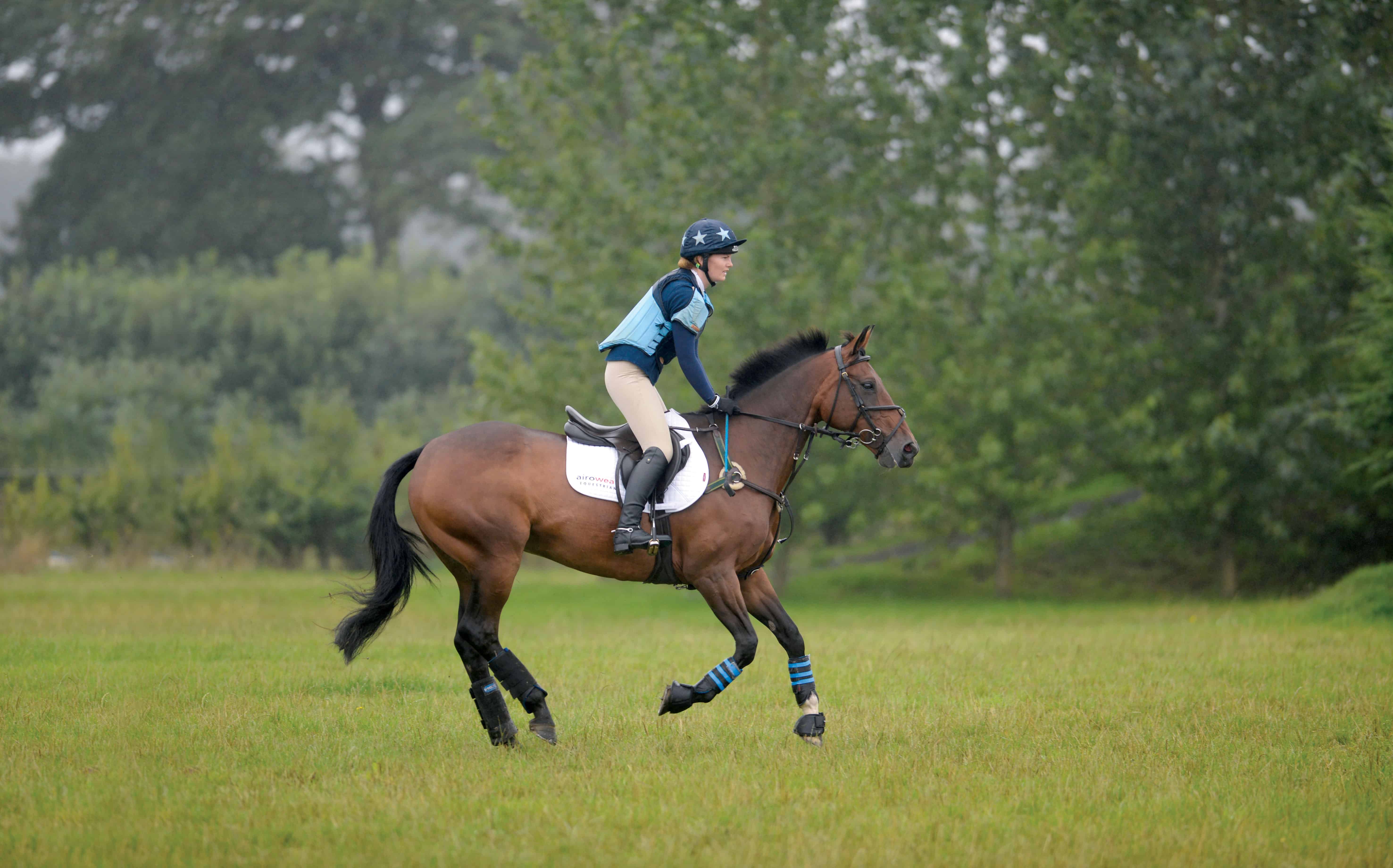
Minimising interference
Your aids will be twice as effective if your horse is sensitive to them and you’re able to use your body less. By teaching your horse to respond to a light aid, you can ride more quietly and effectively.
The importance of quiet riding
Quiet riding is a real skill. Here’s an example from another sport – a novice golfer hits a ball. They want to hit it twice as far, so logic says they need to do everything twice as much. This means they exaggerate their bad technique twice as much, as well as the good elements. The ball goes less far because they exaggerated their faults so much.
If you ride strongly by moving around loads, that has a negative effect on your horse. The one thing that is going to help when a horse backs off is the small area on the back of your heel, whether you’re wearing spurs or not, which helps him to jump. Anything you do with your hand, seat or shoulders is more of a hindrance.
Good riding is all about stripping it down to being as efficient as possible. You can be really effective without any unnecessary movement – learn how to settle him down, then when you want to zip him up, just use your heel. In time, your horse will become tuned to being able to quieten and lighten from quiet aids, not loud ones. Developing this skill means that rather than slowing your horse to create energy, you can add energy into a long gallop. This helps your horse stay relaxed and uses less energy, which makes him less tired and means his speed stays high the whole way around the course, helping you avoid time faults.
Of course, there is a time when it’s important to bring the speed down – for example, at a gate – but remember that speed and revs aren’t mutually exclusive.
My ethos of quiet riding uses two key pieces of kit. I strongly believe in the benefit of spurs and a schooling whip when cross-country schooling and training. Spurs allow you to rev up your horse by using your heel to zip up his engine, while a schooling whip helps him remain forward without a big aid or having to take your hand off the rein to use a short whip. Don’t go schooling without a whip or spurs and expect any horse – green or advanced – to do a good job because you need to be able to help him. These artificial aids help you to do that and mean that between helping him, you can be as quiet as possible.
I advocate the use of spurs on every horse for cross-country riding. Many riders with hot horses think that because their horse is generally trying to accelerate and is perhaps struggling with tension, they should be focusing on trying to diffuse that tension and slow him down. This is true, but even on the most forward-going horse, you’ll eventually want to jump something that’s out of his comfort zone. You don’t have to use your spurs – what makes them so useful is that you can choose when you need them. Whether you’re approaching the Vicarage Vee or the first fence in a local hunter trial, you’ll find that your hot, strong horse backs off. However, with a spur as back-up, you can be there to support and encourage your horse. So often, I see horses whose riders have nothing to push them forward when they’re out of their comfort zone and this is when the horse will scare himself.
I like to cross-country school with a schooling whip, rather than a jumping stick. A jumping stick requires you to take one hand off the reins or use the stick down your horse’s shoulder, both of which are ineffectual. When you’re jumping into water or over a ditch from a slow trot, or if your horse goes to hesitate and spook at a fence, the first thing he does is freeze with his hindlegs. Having a schooling whip that you can use with the most gentle movement of your hand and without taking your hand off the rein means you can make very light contact. It’s not about hitting your horse, you’re just giving him a touch on the hindquarters, which can be enough to ignite his jump and help him jump the fence. If you ride with a jumping whip you have to hit him down the shoulder, which is less effective, or take one hand off the rein, which causes other problems. By using a schooling whip, you can give your horse the lightest possible aid, which helps your horse to move forward into the fence that has backed him off. This shouldn’t be a rough or domineering aid – it should have a similar response to a static shock. By keeping your hands on the reins and your movements minimal, you’re providing the support he needs throughout your body.




